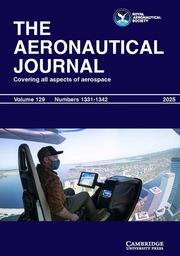No CrossRef data available.
Article contents
An experimental investigation of the effect of a supercooled large droplet impingement on freezing behaviour
Published online by Cambridge University Press: 13 May 2025
Abstract
The impinging–freezing of supercooled water droplets (SLDs) is the root cause of aircraft icing. This work presented an experimental investigation of a millimeter-sized supercooled droplet (−10  $^\circ {\rm{C}}$) impact onto cold surfaces. For the majority of the current research on freezing behaviour, the quantitative analysis of impingement contributions was neglected. The present study established prediction models for the frozen area ratio, initial freezing height and solidification time by changing Weber number and Stefan number. The results showed that with the decrease in surface temperatures, the maximum spreading factor and the peak height factor were unchanged; however, the receding velocity of the liquid film reduced. Besides, regardless of the three freezing modes (quasi-static, instantaneous and delayed), the frozen area ratio consistently increased with decreasing Weber number. For the Stefan number exceeded 0.12, the frozen area ratio increased with decreasing surface temperature; otherwise, it was independent of the surface temperature. In addition, the initial height of asymmetrical frozen droplets was characterised using the ‘two-ellipse’ method, revealing an inverse proportionality to the square root of the frozen area ratio. Furthermore, the solidification time of the hemisphere and pancake frozen droplets shortened with the decrease in the initial height and surface temperature. This fundamental study provides valuable insights for understanding aircraft icing and optimising anti-icing systems.
$^\circ {\rm{C}}$) impact onto cold surfaces. For the majority of the current research on freezing behaviour, the quantitative analysis of impingement contributions was neglected. The present study established prediction models for the frozen area ratio, initial freezing height and solidification time by changing Weber number and Stefan number. The results showed that with the decrease in surface temperatures, the maximum spreading factor and the peak height factor were unchanged; however, the receding velocity of the liquid film reduced. Besides, regardless of the three freezing modes (quasi-static, instantaneous and delayed), the frozen area ratio consistently increased with decreasing Weber number. For the Stefan number exceeded 0.12, the frozen area ratio increased with decreasing surface temperature; otherwise, it was independent of the surface temperature. In addition, the initial height of asymmetrical frozen droplets was characterised using the ‘two-ellipse’ method, revealing an inverse proportionality to the square root of the frozen area ratio. Furthermore, the solidification time of the hemisphere and pancake frozen droplets shortened with the decrease in the initial height and surface temperature. This fundamental study provides valuable insights for understanding aircraft icing and optimising anti-icing systems.
Information
- Type
- Research Article
- Information
- Copyright
- © The Author(s), 2025. Published by Cambridge University Press on behalf of Royal Aeronautical Society


